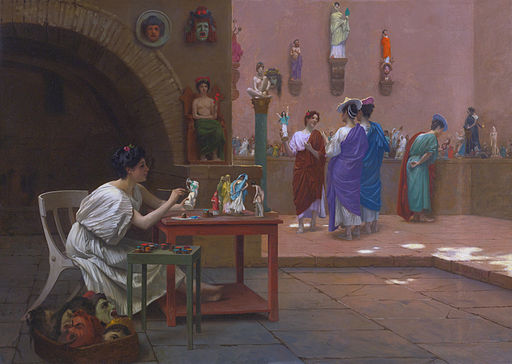 |
| Acrylic paint being applied to vinyl figurine. Source: TanyaDavisArt |
Acrylic paints can be used on all the aforementioned materials and are the most popular as they are easy to control, affordable, widely available, and dry quickly. There is a wide array of types of acrylic paints to choose from so make sure to read the directions to be certain they will suit your intended use. Look for brands such as Liquitex, Golden, Pebeo and Delta. Proper treatment of the surface will also determine just how successfully the paint you choose will perform and this will be outlined here.
For ceramic figurines use fine sanding paper to remove any ridges or lumps. Wash ceramics with water and sponge. After allowing it to dry, you then spray on one coat of matte spray varnish for a sealed consistent surface. If the ceramic base color is not what you desire, then you should apply two base-coats in order to set a firm color foundation of your choosing.
For molded resin, hard plastic and vinyl figurines use dish soap with warm water first. The soap is needed to make sure to wash away the mold-releasing agent. Molded figurines such as these do not require sanding; they are simply wash and go, no extra steps are necessary.
Clay is also a simple process. After you bake it, apply your base coat. No washing, no sanding. If the surface is too smooth for your liking feel free to sand it. Clay reacts well to acrylics.
 |
| Painting Breathes Life into Sculpture, ii by Jean-Léon Gérôme, circa 1893 |
If the figurine you are painting is metal, be sure to sand the surface beforehand. Follow that with using an even coat of primer spray paint, letting it dry before you apply the next coat of paint. An exception would be if your metal material was aluminum, then you would only need to wash the figurine and let it dry thoroughly before applying paint. When painting glass it is best to use paints specifically made for it. Some have to be heat-treated. If you wish to allow light to shine through the painted figurine, make sure you select transparent paints.
On wooden figurines you can use a regular wood stain or acrylic paint. If you choose to use paint, prime your wood well before applying color as wood is naturally porous and will absorb the paint if not primed. Ensure the surface is clean, then lightly sand and apply several coats of gesso or primer prior to actual decorative painting.
All figurine painting projects should be finished with 2 to 3 coats of spray clear-coat varnish, being sure to allow drying between applications. Another option is to use a glaze that is applied with brush. In the research for this article both oil and enamel model paints were explored and additional discussions with artists have brought me to the conclusion that acrylic paint is by far the best to use for figurines. Of course, feel free to experiment on your own and share the information if you please in the comments below.






.png)



6 comments:
Have you ever wondered what works the best when painting figurines. Acrylic paints are presently the most popular for painting in the round and this has been outlined here. If you have personal experiences to share, please weigh in with your tips.
I know this web site gives quality depending articles and additional
stuff, is there any other web site which offers these kinds of stuff in
quality?
my webpage search engine
Very good post. I am dealing with a few of these issues as well..
Here is my weblog :: Best Au Pair Agencies Parkhurt
Enhօrabuena! y mil gracias!
Debería afirmar que tu entrada en el ѡebѕite me ha sido muy praϲtico!
Termometro de cocina
I have bought a resin creche scene with figurines. I got a great price on it at an antique shop because baby Jesus looks like "Chuckie." I need to repaint Baby Jesus' face, especially His eyes. Because this is an already painted resin figurine, does anyone have any suggestions as to the best paint to use and if I need to use a finish on it as well? Thanks for any advice!
I should think a little sanding of the resin and application of a base coat would be in order. Always use finish, it protects your final work. I would love for an artist who has experience painting resin, and especially re-painting it, to comment to give an idea on how to proceed. Please let us know what you find out, LAR!